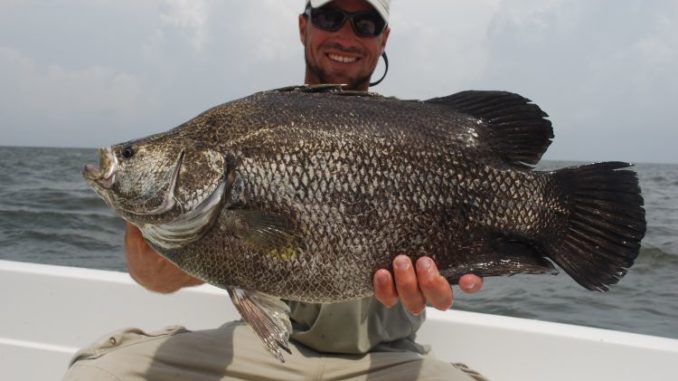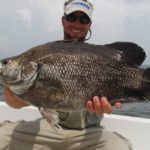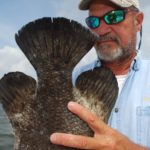
Saltwater anglers get excited about catching a tripletail, a triple treat. They are easy to catch with live bait, they are hard dogged fighters, and they taste great.
They are odd-looking fish, the exact opposite of being streamlined. Their bodies are chunky (with thick meaty fillets) and their colors are drab, ranging from gray-black to blotchy, dark olive.
Their fin arrangement is unusual and is what gives them their common name. Their dorsal (back) and anal (belly) fins extend to the rear, creating lobes that make it look as if the fish has three tail fins.
Their range extends almost world-wide in tropical and temperate waters, except for the Pacific coast of North America. Because of its wide range, it carries a long list of names in the many languages of the world.
In Louisiana it is sometimes referred to as a “blackfish,” obviously in reference to its body color. Other American names exist. An August 1946 article on the fish in Louisiana Game, Fur and Fish, what is now known as the Louisiana Conservationist magazine, flasher, dormeur, lumpfish, sea perch, chobie, and buoyfish, were given as other names for the creature.
The trait for which they are most commonly known is sluggishly floating on their sides, nose into the current, snugged up next to any sort of cover — buoys, channel markers, jetties, and most especially any sort of floating debris.
The 1946 magazine article mentioned earlier, cited the tactics of a Mr. Edward A. Lafaye, who the author called “one of the most expert Tripletail fishermen in Louisiana.” Lafaye would anchor out four or five 1” x 12” boards, each 15 feet long.
Lafaye targeted the tripletails that were attracted to the shade the boards produced by floating a small, live shrimp under a cork past each board.
Fishermen still hunt for tripletails in a similar fashion today. In eastern Louisiana, they often cruise down crab trap lines, inspecting each cork for the glimmer or shadow of a tripletail closely hugging it and usually floating on its side.
When one is spotted, the angler swings the boat in a wide circle and idles back to within casting distance. In eastern Louisiana, fishing for tripletails is most often done in major saltwater lakes, bays, and sounds.
In western Louisiana, where such waters are few and far between, fishermen look for them offshore, but within sight of land. The patterns of the gulf’s currents accumulate large amounts of floating debris of every kind off of Cameron Parish.
These attract the fish just as do crab trap corks in eastern Louisiana. In either area, the bait that tripletail simply can’t refuse are live shrimp. Once hooked, these clunky-looking fish become very active and it’s not at all unusual to have them jump clear of the water.
Tripletail grow large. The IGFA world record is a 42-pound, 5-ounce fish caught off of South Africa in 1989. Louisiana’s record fish of 39.5 pounds was caught by Mrs. Jimmy Toups in 1959.
Apparently the Toups family has a thing for tripletails. Mrs. Toups also caught a 29.0-pounder in 1970, which ranks number 10 on the list. Jimmy Toups caught the number 6 fish (32.0 pounds), also in 1970. Jeff Toups caught a 33.75-pound fish in 1973, which holds down the third spot.
Tripletails are found everywhere in saltwater, from inshore waters and passes out to blue water, but are common nowhere. They are migratory, being found on the Gulf coast April through early October, migrating to the south during the winter months.
They grow fast and mature early. Males will mature at 1 year old and as small as 12 inches long. Females begin maturing at 18 inches long and less than 2 years of age.
They lay lots of eggs. Between May and September, a female will spawn every 3 to 5 days (18 to 31 times per season) producing 4.6 million to 9 million eggs. Spawning takes place offshore.
Young tripletails also gravitate towards floating cover, most commonly sargassum weed mats.
Tripletails apparently love to eat. Their stomachs contain equal amounts of crustaceans (shrimp and crabs) and fish. The crabs they eat are not bottom crabs, but rather swimming crabs in the same family as blue crabs.
In one extensive study in Mississippi, shrimp made up 19 percent of their diet by number and 33 percent by volume. Crabs were 32 percent by number, but only 16 percent by volume. Obviously, the crabs they ate were very small.
In the finfish group, menhaden (pogies) were the most important identifiable food item, followed by Atlantic bumper. Overall, only brown shrimp were more important than menhaden in tripletail diets.
Thirteen species of finfish were identified in their stomachs, but over half the fish remains were unidentifiable. Tripletails have sharp teeth, but seem to feed mostly by sucking food into their mouths rather than biting it.
On the table, tripletail simply cannot be beat. Their lean but moist flesh cooks up snow white and is fork-flakey.




